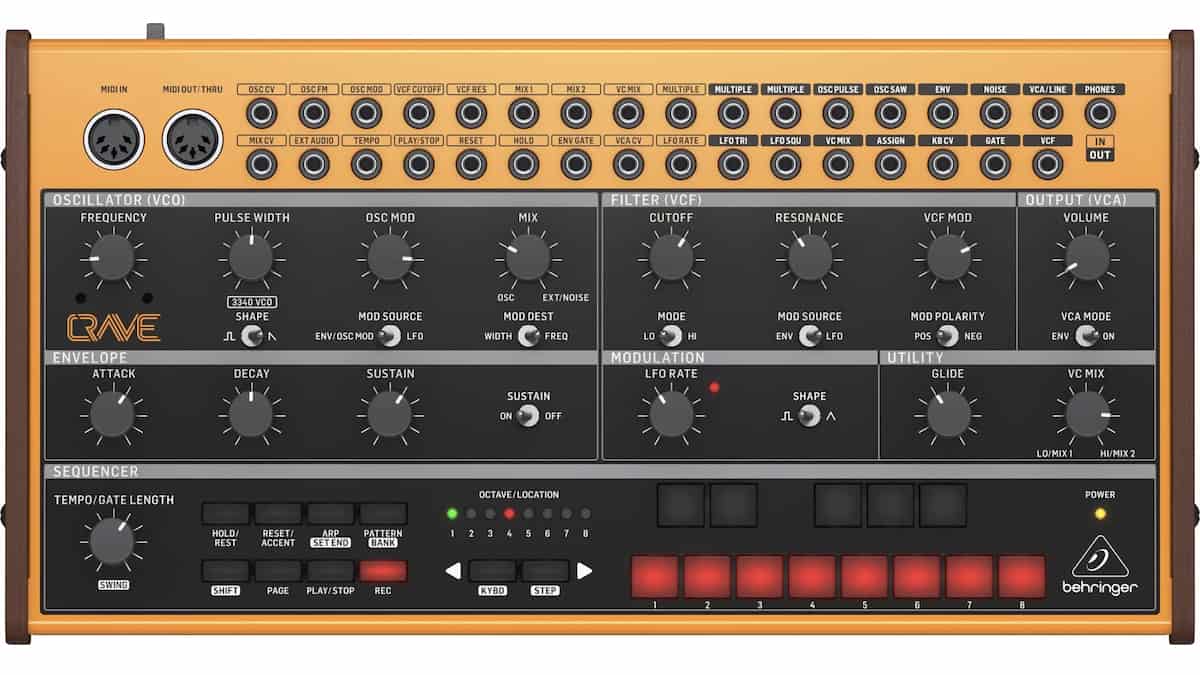Analog
Behringer Beat: Crave Review

Although the Crave is Behringer’s least expensive all-in-one synth module, it has a personality all its own.
Behringer is enjoying great success issuing reproductions of well-known synthesizers, but they have some original designs, too. After the introduction of the Neutron—an affordable, original, dual-oscillator, semi-modular instrument without a keyboard—the company debuted the Crave. This fully analog synth is simpler and even more affordable than the Neutron, but with its own distinctive sound and capabilities. Had Behringer issued the Crave ten years ago, many would have labeled it a Roland TB-303 Bassline imitator. However, Behringer recently debuted a very specific TB-303 clone, the TD-3, leaving the Crave to stand on its own.
The Crave is an economical, playable, single-oscillator monosynth with no patch memory. With over 30 minijack patch points on its top panel, it can serve as the control interface for a Eurorack or similar modular system. You can also route control signals from a modular system to modulate the Crave.
Look Closely
As on the Neutron, the Crave’s analog oscillator is based on a Curtis 3340 chip and generates sawtooth and variable pulse waveforms. You can mix in white noise or an external audio source, as well. A single envelope generator and an LFO can modulate oscillator pitch or pulse width. The envelope is very simple—just attack, decay, and switchable sustain. You can bypass the envelope and set the VCA to the On setting for a constant drone. The fully self-oscillating, 24db-per-octave ladder filter lets you switch between lowpass and highpass responses. It also has controls for cutoff and resonance and scalable positive or negative modulation from the envelope or LFO.
The LFO has a knob for controlling its rate and switchable square or triangle waves. The Glide knob determines portamento rate, of course. One unusual touch is the voltage mixer/balancer, which provides a general-purpose offset voltage and a means to scale incoming external voltages.
The Crave’s sequencer design is found on other Behringer synths, with which the Crave can interchange patterns using Behringer’s Synth Tool software. The sequencer has plentiful control inputs, including Start/Stop, Reset, and Tempo. Thirteen illuminated red and black buttons function as a one-octave keyboard and flash attractively when a sequence plays. Use them to enter as many as 32 notes in step time or live modes. You can access 64 sequences using buttons that double as playback octave selectors and transpose them in real time. Another useful facility is a ratcheting control to create fast, repeated notes.
The arpeggiator has eight available patterns and not just simple up and down. A rotary knob determines tempo or note gate length, or in another mode, the replayed sequence’s swing factor. The Crave synchronizes readily to other time-based elements in your modular system or DAW. You can also control LFO rate with an external voltage.
Interesting Interfacing
The Crave doesn’t lift out of its chassis to fit into a Eurorack case as several other Behringer designs do. Five-pin DIN MIDI In and Out/Thru jacks are on the top panel alongside the control-voltage patch bay. The rear panel has only a USB type-B port, a connection for the small external power supply, and DIP switches to select the MIDI channel.
Every parameter is controllable via 18 CV inputs. Oscillator pitch has two inputs, one scaled for 1V/octave playing and one for vibrato modulation. A third input appears at the mixable Mod Destination control, and you can mix in an external audio input. The filter has cutoff and resonance control inputs. The onboard voltage mixer has its own pair of inputs, so you could have both a sine and a square wave generated externally controlling the resonating filter, for example.
The Crave is a monaural instrument with over a dozen outputs for control voltage and audio signals. You can access white noise and the oscillator’s two waveforms individually. The keyboard buttons send control voltages and gates, so your Crave sitting in front of a modular system can be a keyboard interface to control it all. A minijack headphone output completes the top panel facilities (unless you count the nice pair of wooden end cheeks).
Satisfy Your Cravings
As I mentioned earlier, you needn’t consider the Crave an attempt at a Roland TB-303 replacement, but it can certainly create some very 303-like effects. Choose from squirty, highly resonant sequences and arpeggios, thumping deep bass parts with some thickening pulse-width modulation, or high-pitched sequenced trills and melody patterns.
Straightforward synth timbres are only the beginning of the Crave’s abilities. Patching its individual parameter controls into one another with a few 3.5mm cables (six are included) can create much more complex effects. Using it as a front end for a modular system—giving you keyboard-like control, sequencing, and a basic synth voice that you can expand as far as your modular system can go—affords the Crave practically endless possibilities.
The synth is solidly built and should stand up well to either studio or stage conditions. If you can’t get enough of its sound, its MIDI overflow mode lets you control as many as 16 units polyphonically. You may even find that buying several instruments to make one big polyphonic setup is finally practical and affordable.
The Crave’s U.S. price is $250, in the UK about £150, and in Europe about 140€. That’s extremely affordable (compared to what you’d require to build a comparable Eurorack system) for a rudimentary keyboard, sequencer, arpeggiator, oscillator, filter, envelope, noise source, voltage patch bay, and MIDI interface.
Website: behringer.com
Price: $250


















